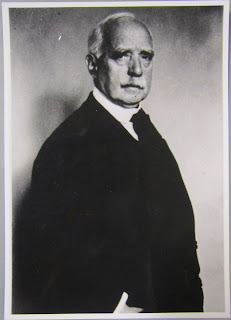Work is progressing well on the tuberculosis case notes
cataloguing project so I thought at this stage it might be a good idea to
learn a bit more about the man who started it all, Sir Robert William Philip.
 |
| Sir Robert Philip, 1857-1939 (P/PL41/TB/029) |
Born in 1857, Philip graduated from the University of
Edinburgh with a degree in medicine in 1882. Further studies took him to
Leipzig, Berlin and Vienna, where he took the opportunity to view the recently
discovered tubercle bacillus. Prior to this discovery there had been much
debate about whether tuberculosis may be hereditary. The discovery of the bacillus proved that it
was an infectious disease, and Philip was quick to realise the implications of
this discovery for treatment. Following his return to Edinburgh and the
establishment of his medical career at the Royal Infirmary, Philip retained an
interest in tuberculosis, hypothesizing that the various lesions caused by
tuberculosis were symptoms of a systemic infection. Coupling this theory with his
understanding of tuberculosis as an infectious disease, Philip began his life’s
work of establishing a co-ordinated system of tuberculosis treatment in
Edinburgh.
He opened the Royal Victoria Dispensary on Bank Street in
1887, which came to operate at the centre of a range of co-ordinated services
in a system known as the Edinburgh Scheme.
A large part of this scheme was identifying contacts of tuberculous
patients and promoting good hygiene to prevent the spread of the disease. (For
more information, see my earlier post.)
The success of these institutions added credibility to Philip’s advocacy for a
notification scheme, which influenced tuberculosis policy throughout the UK
throughout the early twentieth century, particularly the national requirement for
the notification of patients with tuberculosis and other infectious diseases. His
work in Edinburgh also led to the bringing together of one of the first herds
of tuberculosis-free cows, diminishing the spread of bovine tuberculosis to
children. His influence was acknowledged in 1913, when he was awarded a
knighthood.
 |
| Royal Infirmary Summer Residents, 1883. Robert Philip is the first seated gentleman on the left-hand side. (P/PL41/TB/069) |
Philip’s career was not limited to his work at the Royal
Victoria Hospital, which was handed over to the City of Edinburgh in 1914. In
1917 he was the first to take the Chair of Tuberculosis at the University of
Edinburgh where he led a compulsory course of lectures for medical students,
spreading his influence to the next generation of doctors. As well as his
specialism in tuberculosis, Philip worked as a physician at the Royal Infirmary
until 1921, where he taught clinical medicine. He served as president to many
medical associations, and sat on the council of the International Union Against
Tuberculosis.
Sir Robert Philip died in 1939, leaving a permanent
influence on the treatment of tuberculosis and preventative medicine through
his advocacy for notification of tuberculosis patients and surveillance of
their contacts. His influence was not limited to Edinburgh, or even the UK, but
was felt far afield in countries such as the USA, where his insight was well-respected.
Even after the discovery of effective antibiotics led to a new cure for
tuberculosis, Philip remained respected by physicians for the correctness of
many of his theories and the effectiveness of his work.
 |
| Plaque commemorating Sir Robert Philip at 13 Bank Street, the original site of the Royal Victoria Dispensary. (P/PL41/TB/035) |
Sources:
Munks Roll: http://munksroll.rcplondon.ac.uk/Biography/Details/3541NAPT, Sir Robert W Philip 1857-1939: Memories of his friends and pupils (1957)
Steve Sturdy, ‘Philip, Sir Robert William (1857–1939)’, Oxford Dictionary of National Biography, Oxford University Press, 2004; online edn, Jan 2011 [http://www.oxforddnb.com/view/article/35505, accessed 15 Oct 2015]
No comments:
Post a Comment